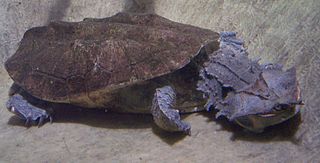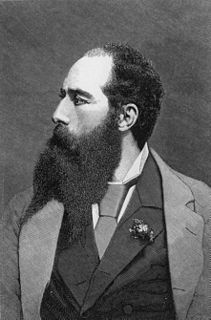
Chelidae is one of three living families of the turtle/tortoise suborder Pleurodira, and are commonly called Austro-South American side-neck turtles. The family is distributed in Australia, New Guinea, parts of Indonesia, and throughout most of South America. It is a large family of turtles with a significant fossil history dating back to the Cretaceous. The family is entirely Gondwanan in origin, with no members found outside Gondwana, either in the present day or as a fossil.

Luigi Maria D'Albertis was an Italian naturalist and explorer who, in 1875, became the first Italian to chart the Fly River in what is now called Papua New Guinea. He undertook three voyages up this river from 1875 to 1877. The first was conducted in the steamer SS Ellengowan and the other two in a smaller ship named the "Neva" which was chartered from the Government of New South Wales. Throughout the three voyages, D'Albertis was consistently involved in skirmishes with the various indigenous people living along the river, using rifle-fire, rockets and dynamite to intimidate and, on occasions, kill these local people. He also frequently employed destructive dynamite fishing as a technique of obtaining aquatic specimens for his collection. His expedition stole many ancestral remains, tools and weapons from the houses of the locals. He also collected specimens of birds, plants, insects and the heads of recently killed native people. Contemporary explorers and colonial administrators of d'Albertis were almost universally critical of the methods employed by D'Albertis in his expeditions up the Fly and more modern accounts, such as Goode's "Rape of the Fly" are equally condemnatory.

Elseya is a genus of large side-necked turtles, commonly known as Australian snapping turtles, in the family Chelidae. Species in the genus Elseya are found in river systems in northern and northeastern Australia and throughout the river systems of New Guinea. They are identified by the presence of alveolar ridges on the triturating surfaces of the mouth and the presence of a complex bridge strut.

Elseya branderhorsti is a species of freshwater turtle in the family Chelidae. The species is endemic to southern New Guinea, in West Papua Indonesia and Western Province of Papua New Guinea. Until recently it has been a confusing species due to its lost holotype and its sympatry with another, undescribed, species. E. branderhorsti is currently listed as Vulnerable on the IUCN RedList in part due to its vulnerability to the Asian turtle trade.

The Western New Guinea stream turtle or New Guinea snapping turtle is a species of freshwater turtle in the Chelidae family. It is found in the Bird's Head Peninsula and the Bomberai Peninsula west of Cenderawasih Bay, and on the island of Waigeo of West Papua, Indonesia.

Emydura, the Australian short-necked turtles, are a genus of turtles in the family Chelidae. It was paraphyletic with Elseya. Consequently, it was split into two genera Myuchelys and Elseya by Thomson & Georges, 2009. They can grow quite large, 30 cm or more is not unusual and have a life span of around 20–30 years. They generally do not hibernate as their warmer climate lets them remain active all year round; they also spend more time in the water than other varieties. They are considered omnivore but rely on a constant supply of meat to remain healthy, feeding on basically anything that will fit into their mouth.

The red-bellied short-necked turtle, pink-bellied side-necked turtle, or Jardine River turtle is a species of turtle in the family Chelidae.

Helicia is a genus of 110 species of trees and shrubs, constituting part of the plant family Proteaceae. They grow naturally in rainforests throughout tropical South and Southeast Asia, including India, Sri Lanka, Indochina, Peninsular Malaysia to New Guinea and as far south as New South Wales.

Bellinger River, an open and trained mature wave dominated, barrier estuary, is located in the Mid North Coast region of New South Wales, Australia.
River turtle may refer to:

The Turama–Kikorian languages are a family identified by Arthur Capell (1962) and part of the Trans–New Guinea languages (TNG) family in the classifications of Stephen Wurm (1975) and Malcolm Ross (2005). The family is named after the Turama River and Kikori River of southern Papua New Guinea; the alternative name is based more narrowly on the Omati River.

New Guinea is the world's second-largest island, and with an area of 785,753 km2 (303,381 sq mi), the largest island in the Southern Hemisphere. Located in Melanesia in the southwestern Pacific Ocean, it is separated by the 150 km wide Torres Strait from the Australian continent. Numerous smaller islands are located to the west and east. The eastern half of the island is the major land mass of the independent state of Papua New Guinea. The western half, known as Western New Guinea or West Papua, forms a part of Indonesia and is organized as the provinces of Papua and West Papua.

The Gulf snapping turtle or Lavaracks' turtle is a large species of freshwater turtle in the sidenecked family Chelidae. The species is endemic to northern Australia in northwest Queensland and northeast Northern Territory. The species, similar to other members of the Australian snapping turtles in genus Elseya, only comes ashore to lay eggs and bask. The Gulf snapping turtle is a herbivore and primarily consumes Pandanus and figs.

Emydura macquarii, is a wide-ranging species that occurs throughout many of the rivers of the eastern half of Australia. It is found primarily in the Macquarie River basin and all its major tributaries, along with a number of coastal rivers up the New South Wales Coast. It is also found in the coastal Queensland rivers and the Cooper Creek ecosystem, along with Fraser Island.
The northern yellow-faced turtle is a species of medium-sized aquatic turtle in the family Chelidae. It inhabits slow-flowing rivers, streams, billabongs and paperbark swamps across much of northern Australia.

Emydura victoriae, also known commonly as the red-faced turtle and the Victoria short-necked turtle, is a species of medium-sized aquatic turtle in the family Chelidae. The species inhabits rivers, streams and permanent water bodies across much of northern Australia.

Elseya schultzei, commonly known as Schultze's snapping turtle, is a species of chelid turtle endemic to northern New Guinea.

Elseya rhodini, the southern New Guinea stream turtle, is a recently described aquatic species of chelid turtle found south of the central ranges of New Guinea. It inhabits small streams that flow into the major river drainage's south of the ranges.
Choanocotyle elegans is a species of flatworms in the family Choanocotylidae. It infects Australian freshwater turtles. It was described from the small intestine of Chelodina expansa and Emydura macquarii.
Trimeresurus gunaleni, also known as Gunalen's pitviper, is a species of pit viper endemic to Sumatra (Indonesia). It is venomous.













